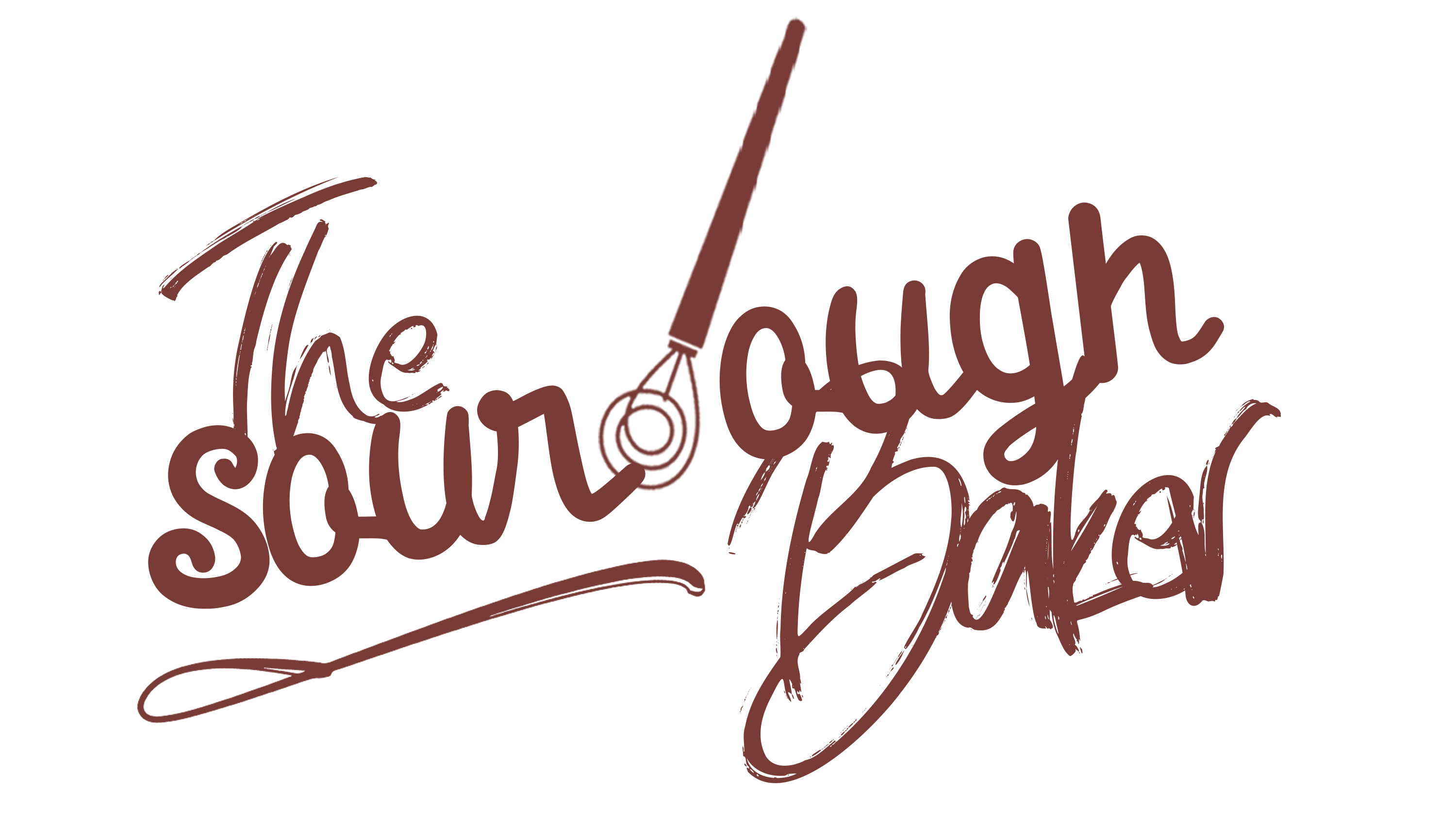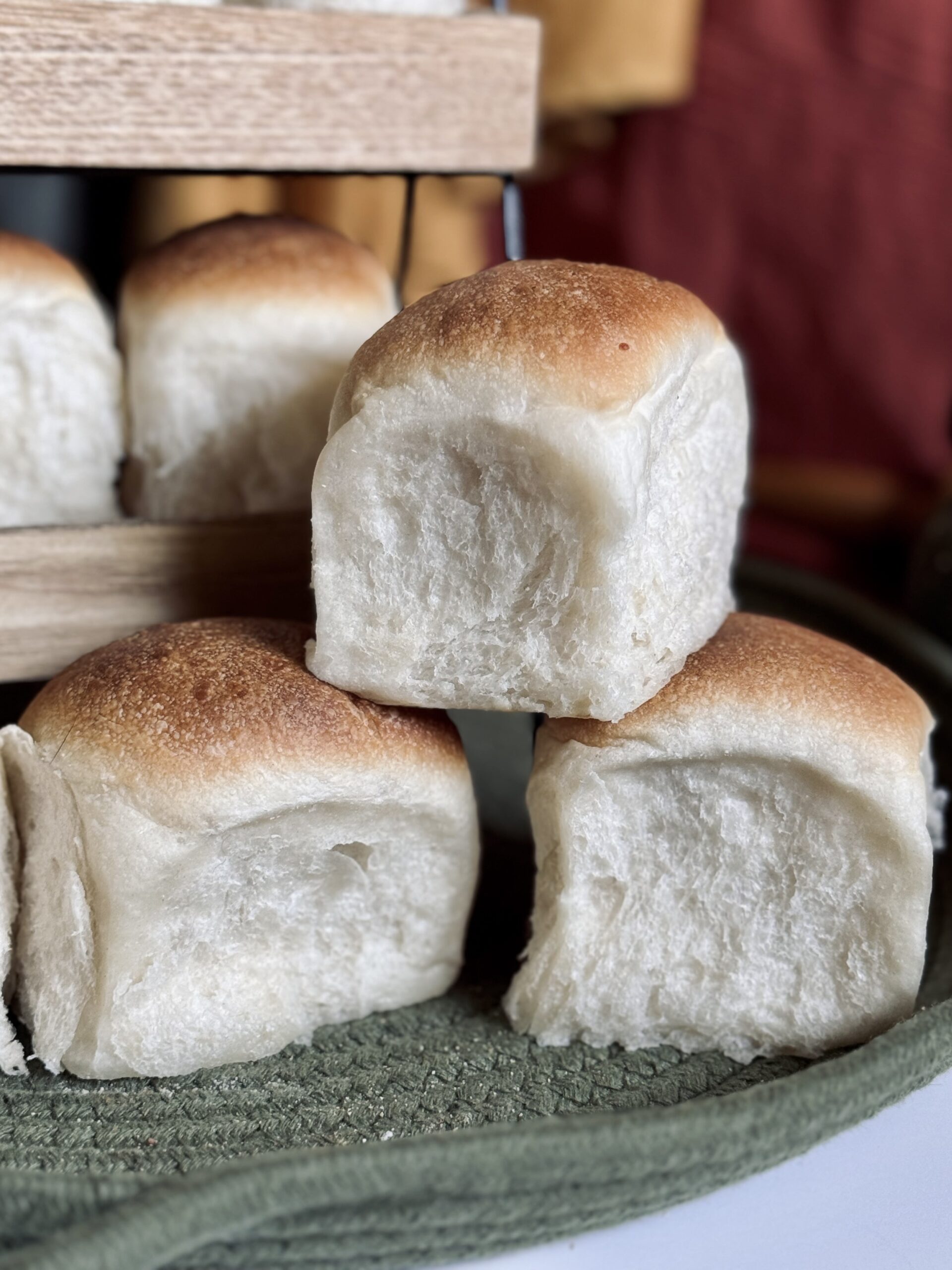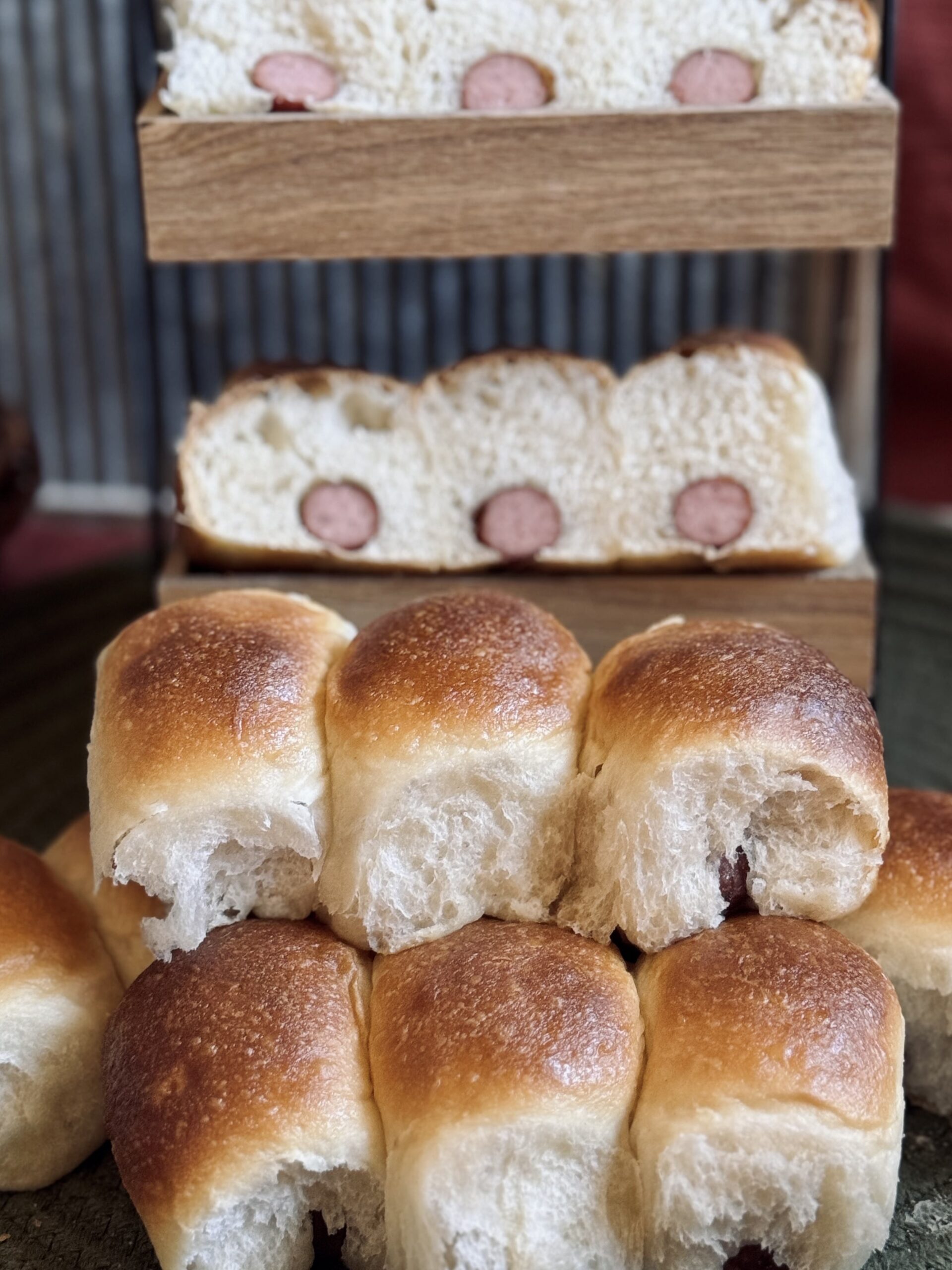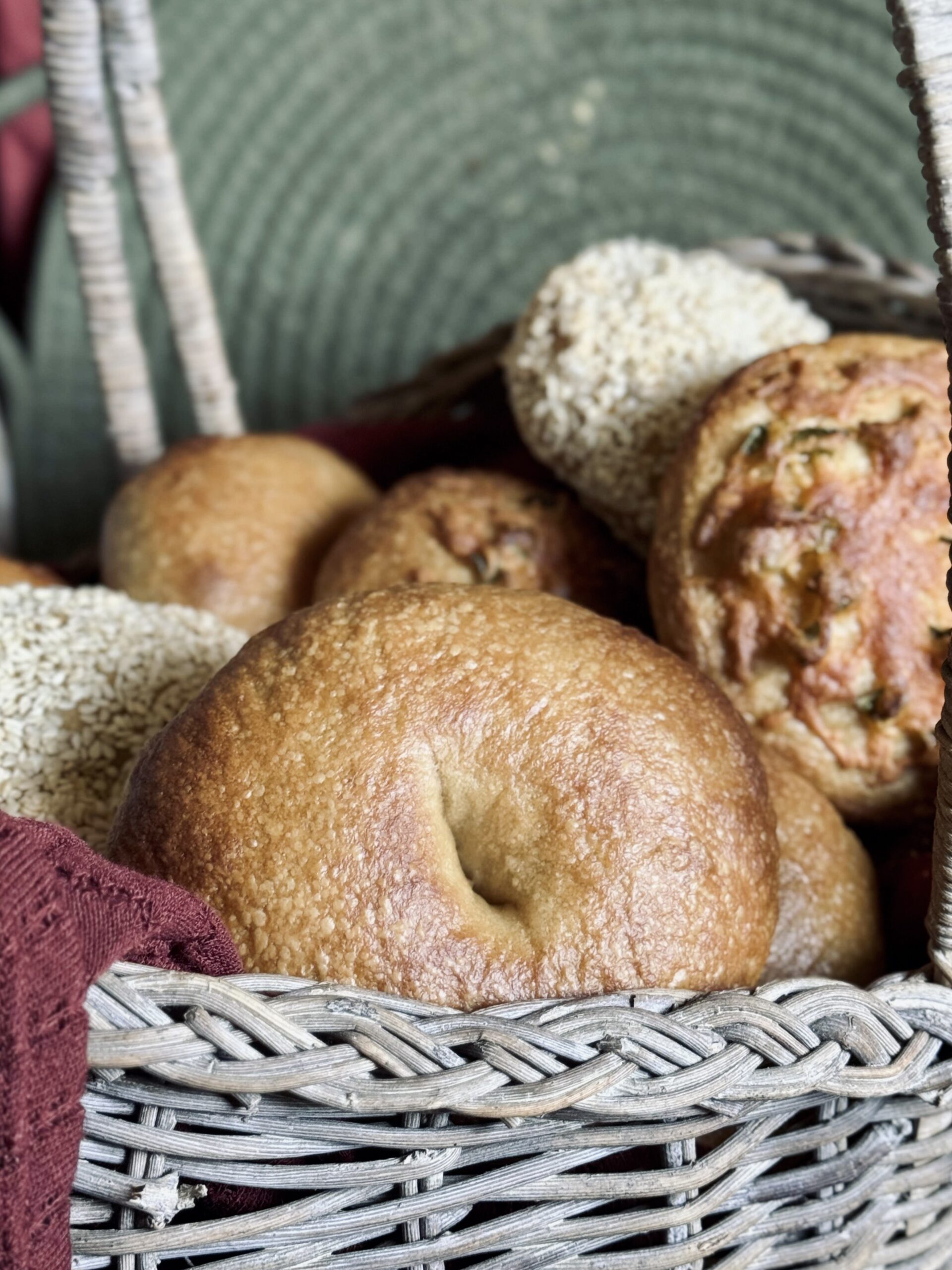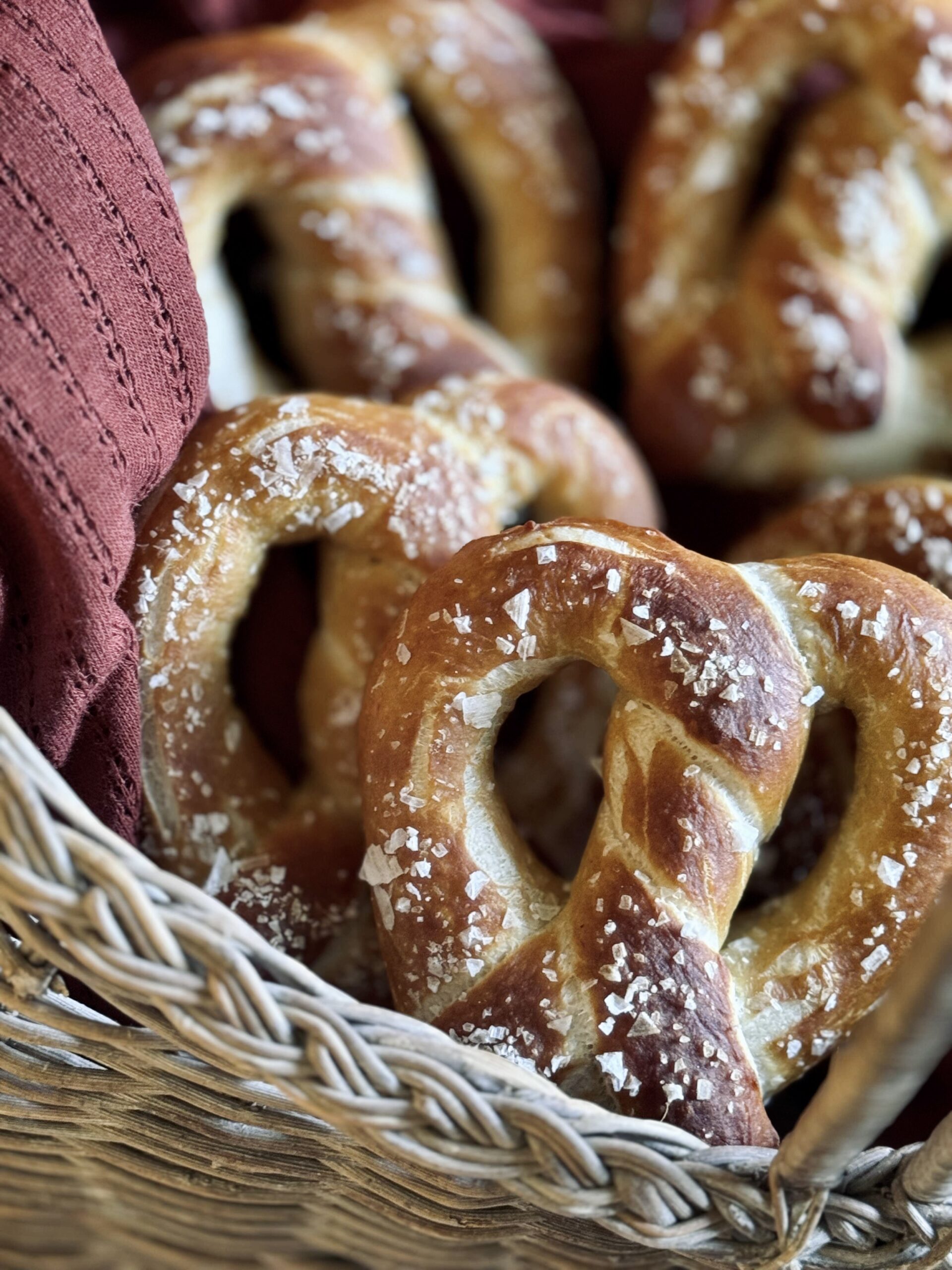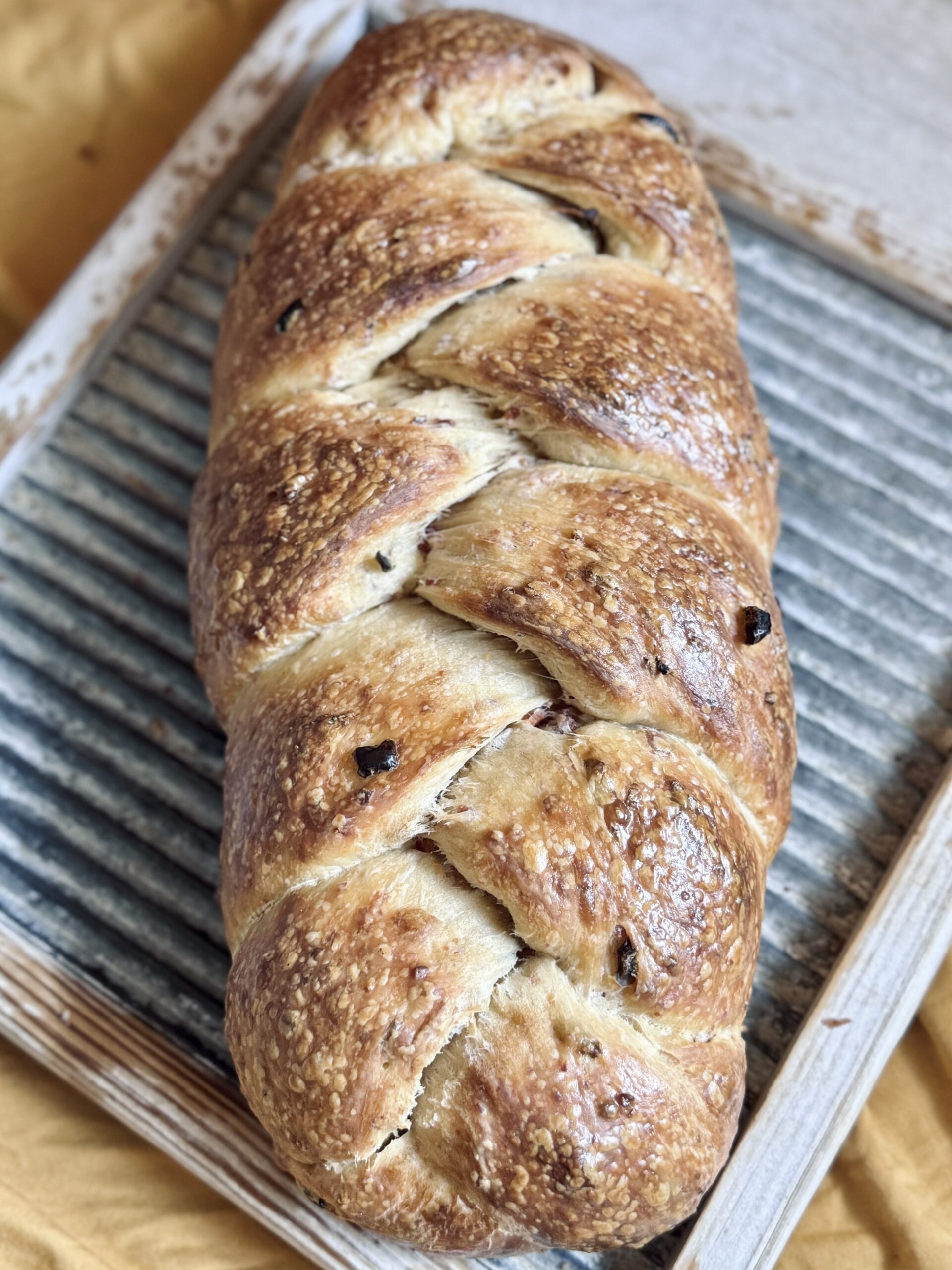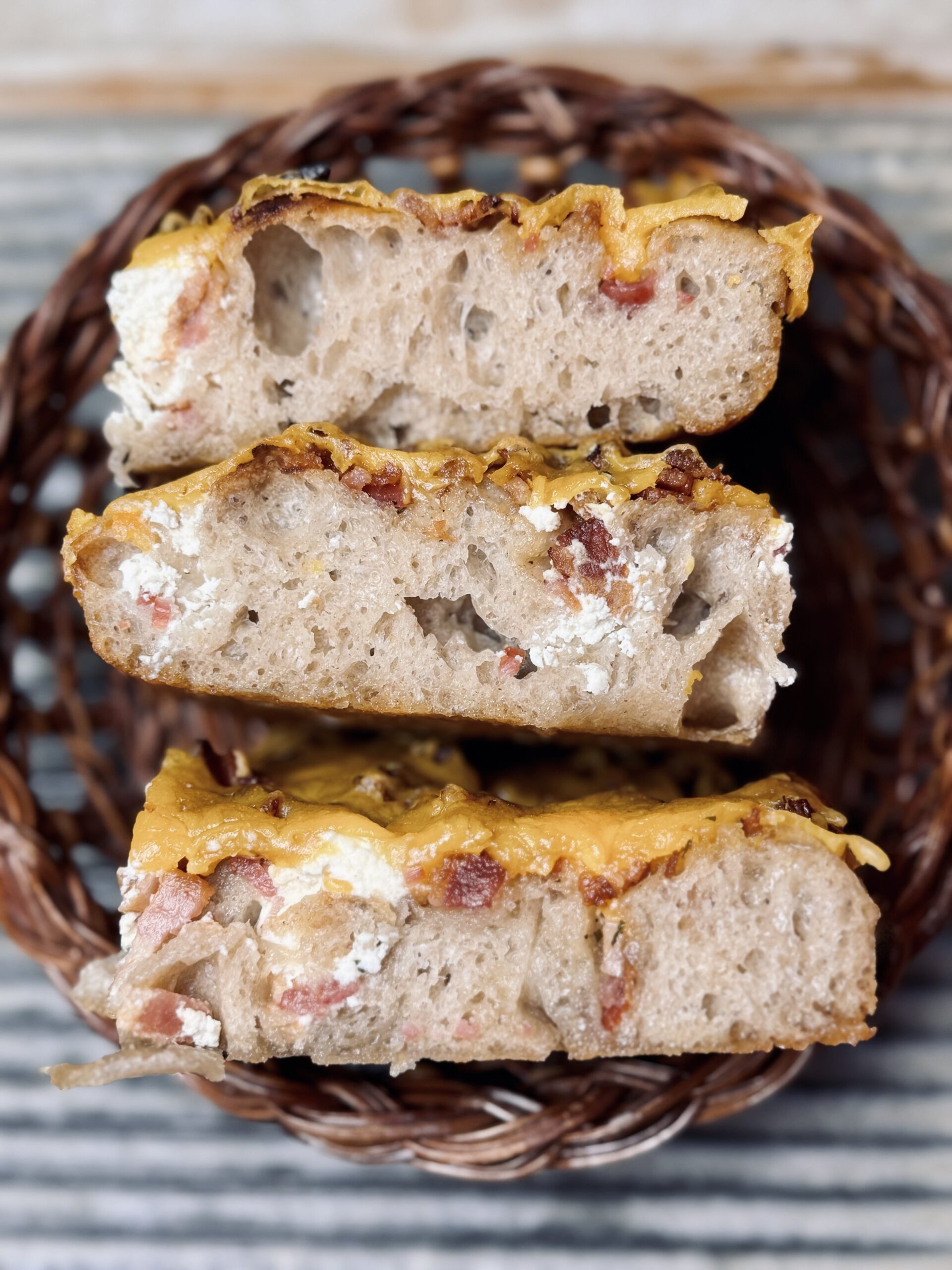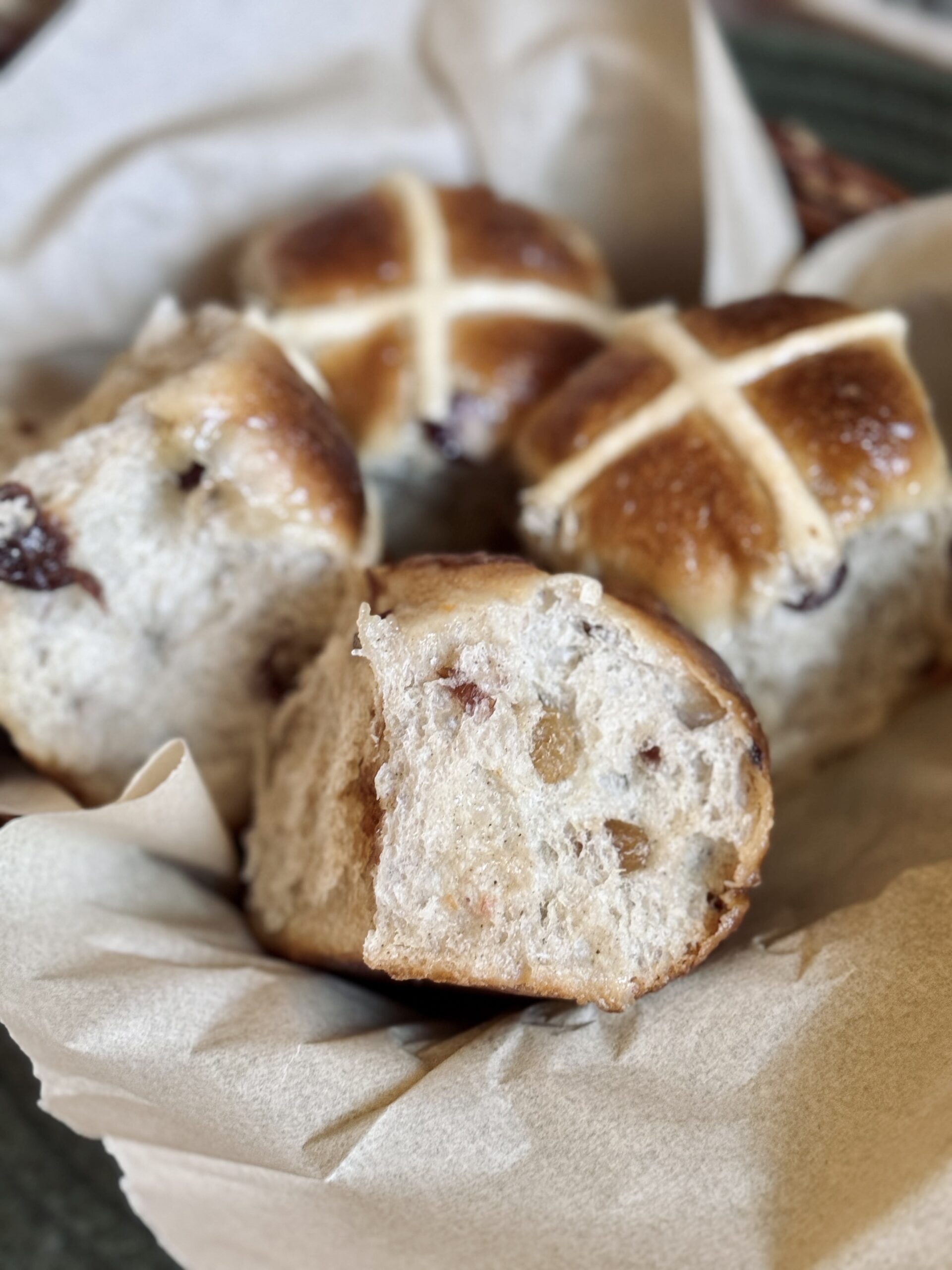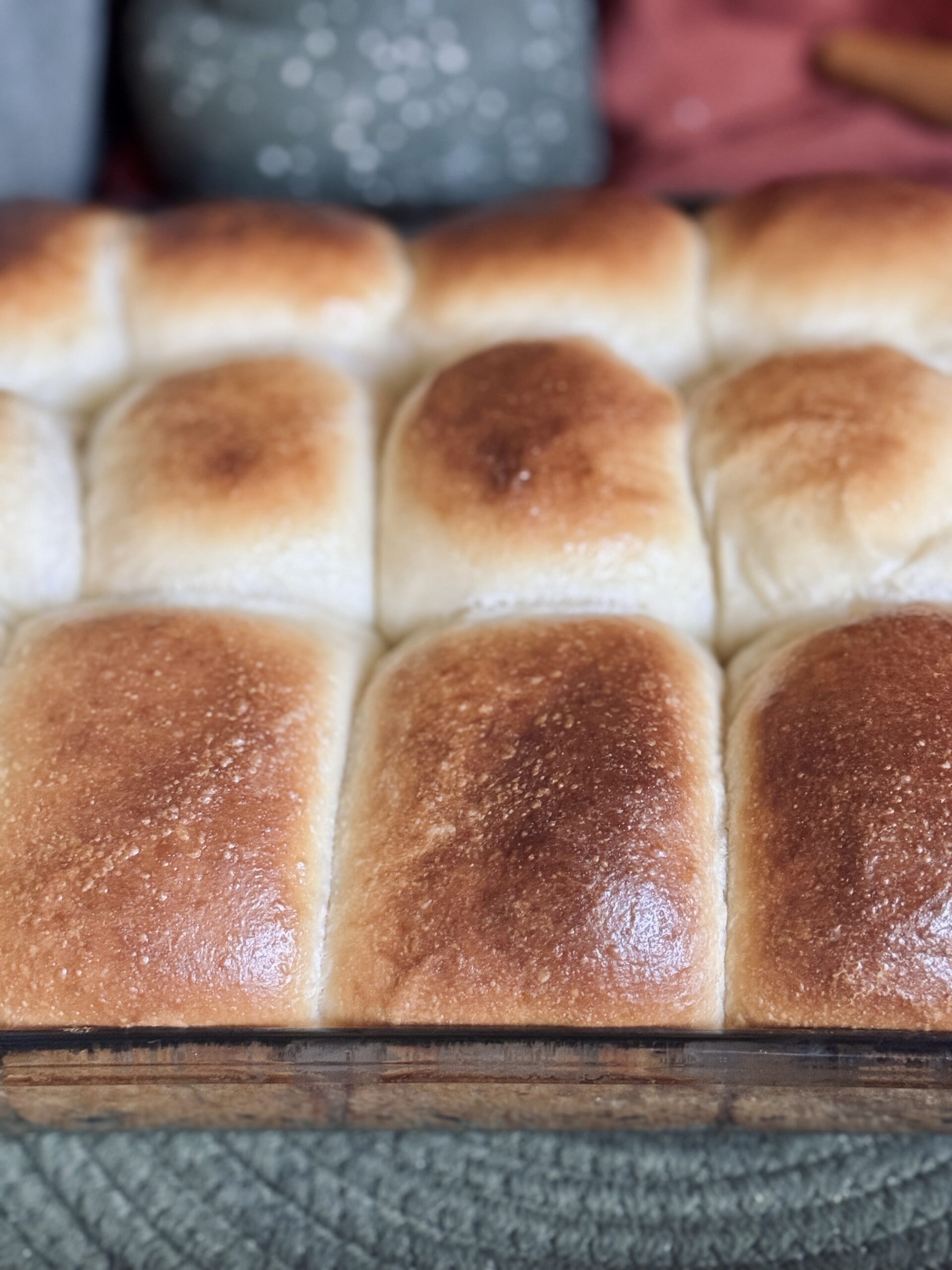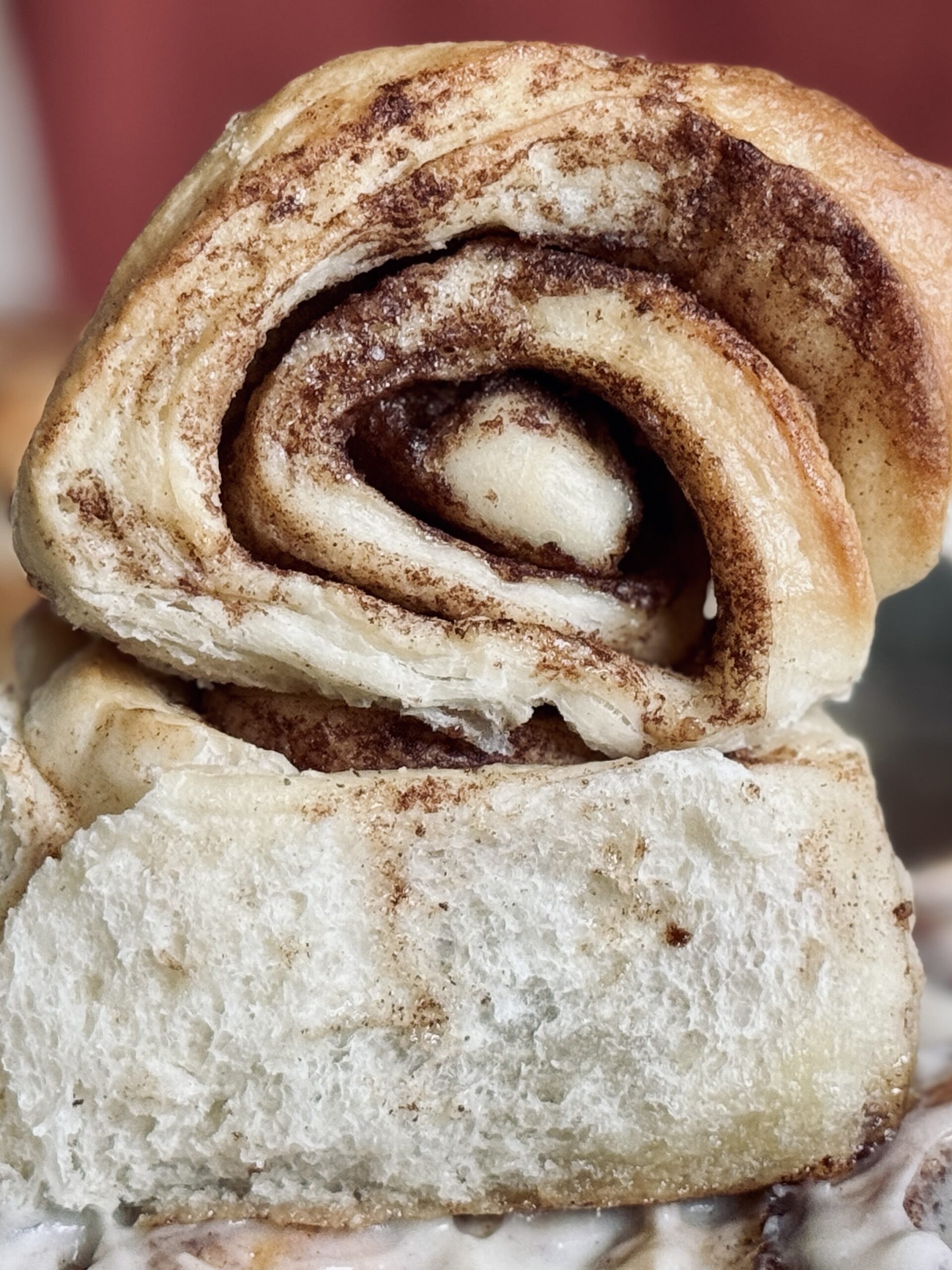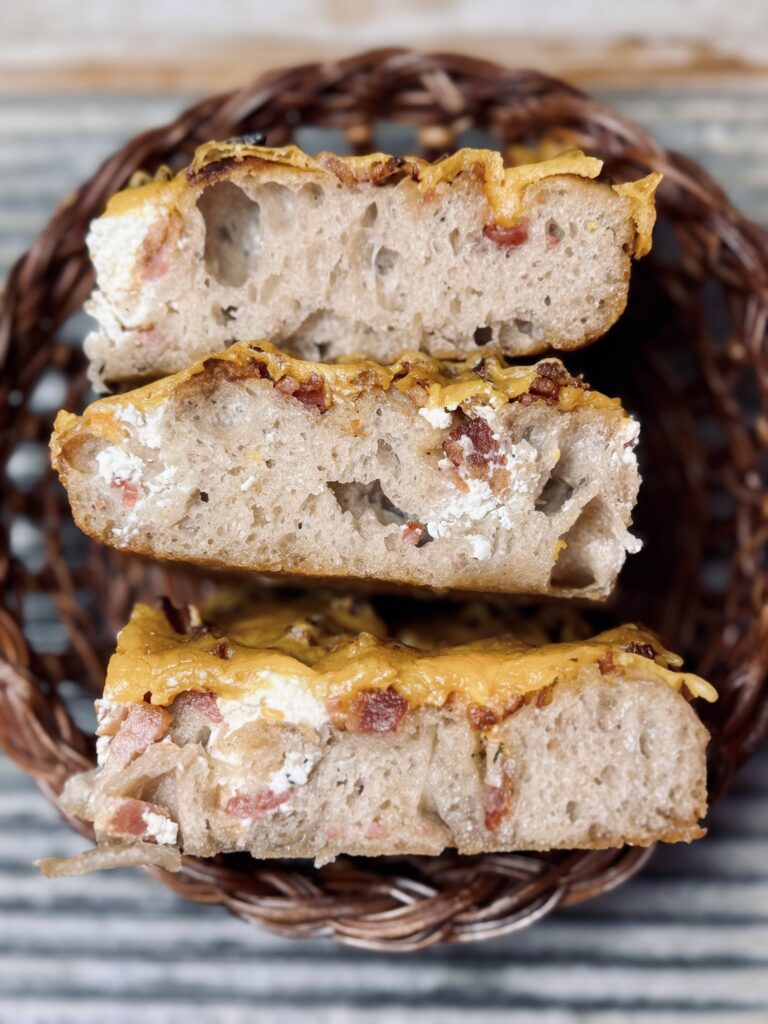About This Recipe
Talk about focaccia with a twist! This recipe is inspired by King’s Hawaiian Ham and Swiss Sliders, except – make it focaccia.
The focaccia gives this recipe an even more savory flavor compared to Hawaiian rolls. Hawaiian rolls are enriched with butter, eggs, milk, and sugar, which creates a sweet, rich, creamy, tender roll. Focaccia is simple: flour, water, salt, sourdough starter. Focaccia is just bread – not sweet, rich, tender bread. Because I haven’t used enriched bread, there isn’t actually any hint of sweet in this dish. The butter sauce soaks into the dough as it bakes and packs everything with flavor. Meanwhile, the ham and Swiss create the meal by adding protein, which make this focaccia more filling.
What Is Focaccia?
Focaccia is a type of Italian bread known for its dimpled surface, which helps infuse olive oil and seasonings throughout the bread. It is similar to pizza dough, but typically thicker and softer. Focaccia can be enjoyed plain or with various toppings such as olives, tomatoes, onions, or cheese (or, in this case, ham and Swiss). It’s a versatile bread that can be served as an appetizer, snack, or alongside a meal.
What I Love About This Recipe
When you pack carbs with protein, it’s nearly a meal-in-one. This low-fuss dinner creates balance between making a meal from scratch and time spent in the kitchen. With focaccia, it is nearly impossible to go wrong. This focaccia recipe is second only to my bacon focaccia.
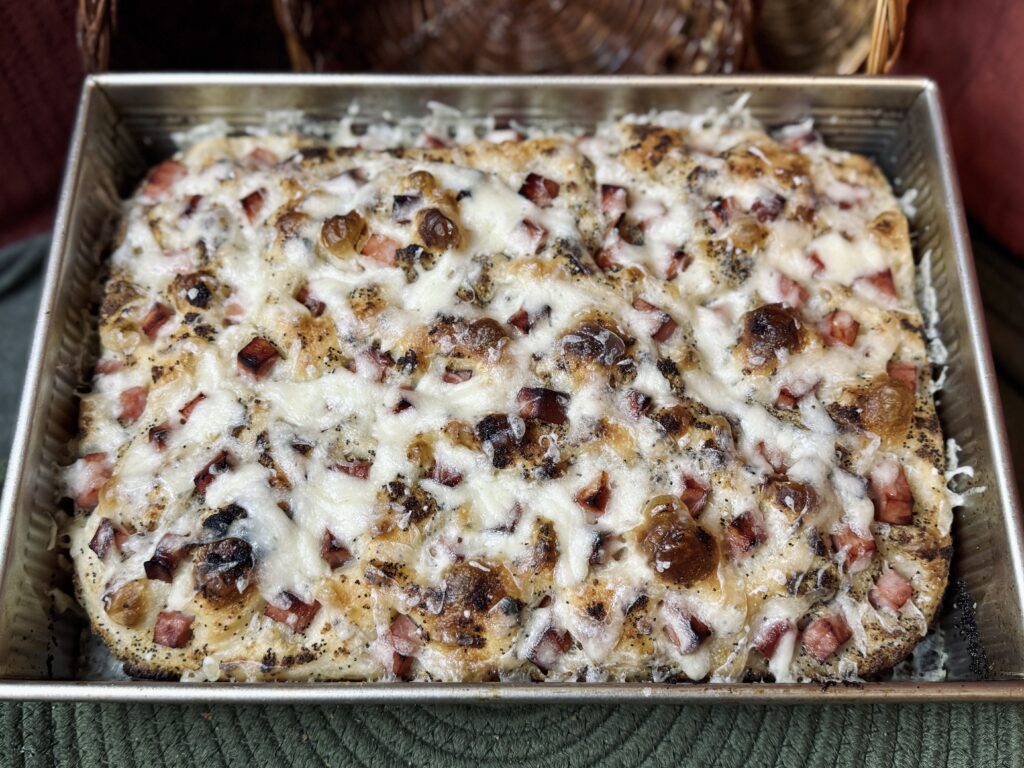
All The “Why’s”
Flour Choice
Here’s the thing about artisan bread: most of the gluten is developed through time during the slow fermentation process. You see, as dough rests, gluten comes together naturally and fermentation provides strength. A strong flour contains more gluten binding proteins, which naturally create a stronger network that traps air and helps the loaf ferment more efficiently.
Recently, I’ve been working with Hayden Flour Mills Artisan Bread Flour over my usual King Arthur Bread Flour. It is fresh and contains more of the bran and germ from the wheat kernel than other flours, which adds incredible flavor to my bread. I’ve been eager to experiment with and dive into a world of better-for-you and better-tasting sourdough baked goods, and this has been a wonderful start.
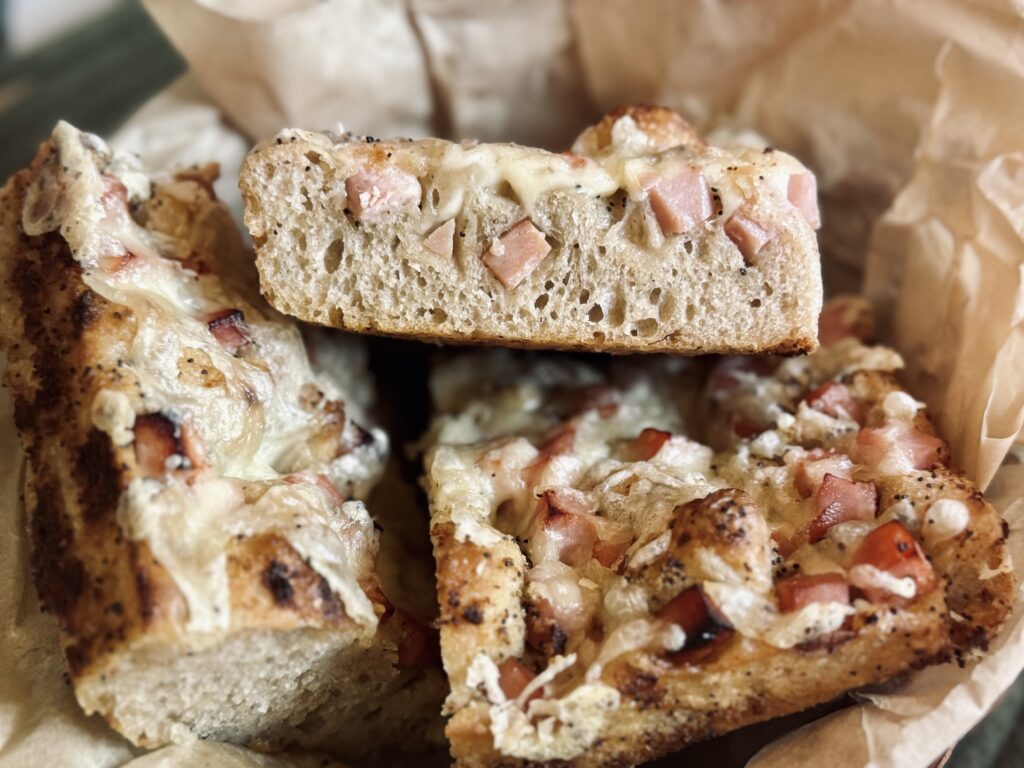
After several wins and fails, I’ve finally discovered how to make this flour fit my typical sourdough bread-making routine. Because it is much fresher than what you can buy on grocery store shelves, it has (what is called) increased enzymatic activity. Enzymes, namely amylase, transform complex sugars into simple sugars that feed yeast. This happens in grocery-store white bread, but at a much slower rate than with fresh flour. Because Hayden Flour Mills Artisan Bread Flour contains more enzymatic activity, yeast are consuming sugars and multiplying at a much faster rate, increasing the speed of fermentation. To compensate for the faster fermentation, I reduce the amount of stater I use in my recipe by 5% (of the total weight of the flour). In addition, due to the increased percentage of bran and germ, the flour itself can absorb more water, which means I can increase the amount of water I use by 5% as well.
Salt
Salt helps bring out flavor (without salt, bread would taste almost like nothing), but also has notable effects on the dough. Salt is a tightening agent, meaning it helps create a more elastic (strong) dough. It does slow fermentation, as well as gluten development, but these are things we must account for in the recipe because we cannot have a recipe without salt. It is important to use just the right amount, enough to bring out the flavor, but not so much that the loaf cannot ferment or come together. I use the standard – 2% salt – in all my recipes, unless otherwise noted.
Hydration
This recipe has an approximate hydration of 86%, if you’re using Hayden Flour Mills Artisan Bread Flour. This is a high hydration recipe, meaning we are working with a fairly wet dough. While loose doughs can sometimes be harder to manage, this is not so with focaccia (at least in my opinion) because we do not have to worry about handling the dough for anything difficult, only to provide some structure through folds. The high hydration adds to the extensibility of the dough, opening the crumb if handled appropriately, and helps create a soft, light texture in the baked bread.
Dough and Gluten Development
Because this dough is unenriched (no fat, sugar, etc.) and because our sourdough starter works slowly, gluten develops naturally over time. This means we can let fermentation do most of the strengthening of our bread, aerating it and building structure, while we take time to fold the dough, which helps fermentation do its best work.
Folding the dough has many benefits, and time you fold it in relation to its stage in fermentation can also change the outcome of your bread completely. More folds up front (sometimes, I also pair this with increased mixing time) creates a more elastic bread, which just means the end result will be taller, sometimes with a more closed crumb. Less folds, or folds that are more spaced out, can mean a flatter bread, but with a more “wild” and open crumb.
For this recipe, I aim for four folds, spaced a minimum of thirty minutes apart. The key is to make sure the dough relaxes completely between each set. This way, the folds are more efficient at structuring the dough.
Bulk Fermentation
It is important to note that fermentation varies significantly depending on temperature and climate. My home generally rests around 68-72 F (20-22 C), so my fermentation times are very extended from someone whose home rests around 75 F (24 C), or even warmer. Always watch the dough and read your baked loaf as best as possible to be able to determine necessary adjustments for your next attempt. The goal is to ferment the dough as long as possible, but not to overproof. The longer the dough ferments, the lighter and airier your bread will be.
If you choose to cold proof your dough, as I do in this recipe, the temperature of your bulk fermentation is very important. A warm dough will continue to rise significantly in the fridge, while a cooler dough will not. I keep this dough around 70 F, and bulk ferment it until it reaches a 50% size increase after folds are complete. If you live in a climate like mine, or even cooler, this method will work fine. But, if your environment is warmer, be sure to watch the dough and consider decreasing the percentage rise as needed for your environment.
Generally, loaves that ferment around 70 F (21 C; this is the temperature I ferment my dough) take about 6 hours to bulk ferment. Colder climates, say 65 F (18 C) take much longer, a minimum of 8 hours. Increase the temperature to 73-75 F (23-24 C), and the bulk fermentation time is reduced to around 4-5 hours. Last, very warm temperatures, 78-80 F (25-27 C) generally take only 2 hours to complete fermentation. All in all, your dough is in your hands, and in your climate.
Note the decreased fermentation period for bulk fermentation. I only ferment this dough to 50% size increase so that I can have a longer final proof. I like to let the dough rest in the pan, untouched, for a good amount of time before baking.
Shaping
Focaccia is beautiful in that it requires no shaping efforts. Simply dump the dough into the desired baking dish, lightly stretching if necessary.
Cold Proof
I stick this dough in the refrigerator, overnight, after shaping. Though placing the dough in the fridge isn’t necessary, I find it creates a deeper flavor (your starter’s bacteria at work!) and adds flexibility to the baking timeline.
Room Temperature Dough
It is better not to bake the dough from cold. Instead, let it continue to rest and puff up on the counter before dimpling and baking. A room temperature dough is essential to obtaining the proper oven spring. The combination of room temperature dough + a very hot oven will create an exploding effect that will help the bread expand and create a beautiful open and even crumb.
Because of the shortened bulk fermentation, we can watch the dough in the baking dish to tell when it is ready. I generally proof this dough on the counter for 6-8 hours (at 70 F, 21 C) after removing it from the refrigerator before dimpling and baking.
Butter Sauce
In place of olive oil, I’ve used the classic butter sauce from the original King’s Hawaiian Ham and Swiss Slider recipe. This sauce is made of melted butter, dijon mustard, onion powder, poppy seeds, and Worcestershire sauce. The butter, for its nonstick properties is most important; everything else is for flavor. I spread this flavorful sauce all over the bottom of the pan (not the sides!) and all over the focaccia dough before I leave it for the final rise. (Spreading it on the sides may result in burning in the oven). Do not be shy! The sauce absorbs right into the focaccia dough as it bakes. Lots of sauce = lots of flavor. Use it all!
Toppings
This recipe is meant to be like a ham and Swiss slider; therefore, I’ve chosen ham and Swiss as the topping. Simple, yet all you need.
Ham
The key is to enough ham to make a meal out of the dish (or don’t, it’s completely up to you), but not so much ham that it is overpowering or that it weighs down the focaccia in the oven. I use one boneless ham steak, which weighs between .75 to .9 pounds.
Swiss
While (in my opinion) Swiss cheese is the perfect compliment to the flavors in this dish, you can use any cheese you like. After the focaccia has baked for thirty minutes (it should be cooked through and nicely browned), the cheese can be added and the focaccia baked again until the cheese is melted to your preference. Adding the cheese in the beginning will result in a very dark, maybe even burnt, cheese and crunchy texture.
Baking Method: Temperature
The best oven spring and crumb comes from baking the dough hot and fast. Though I would prefer to bake my focaccia at 500 F (260 C), I find it burns those delicate air bubbles before the rest of the loaf is baked. Therefore, I chose a temperature of 450 F (230 C) to give the dough the best “pop” in the oven, while also reducing burnt air bubbles, yet still producing a lightly crisp end result.
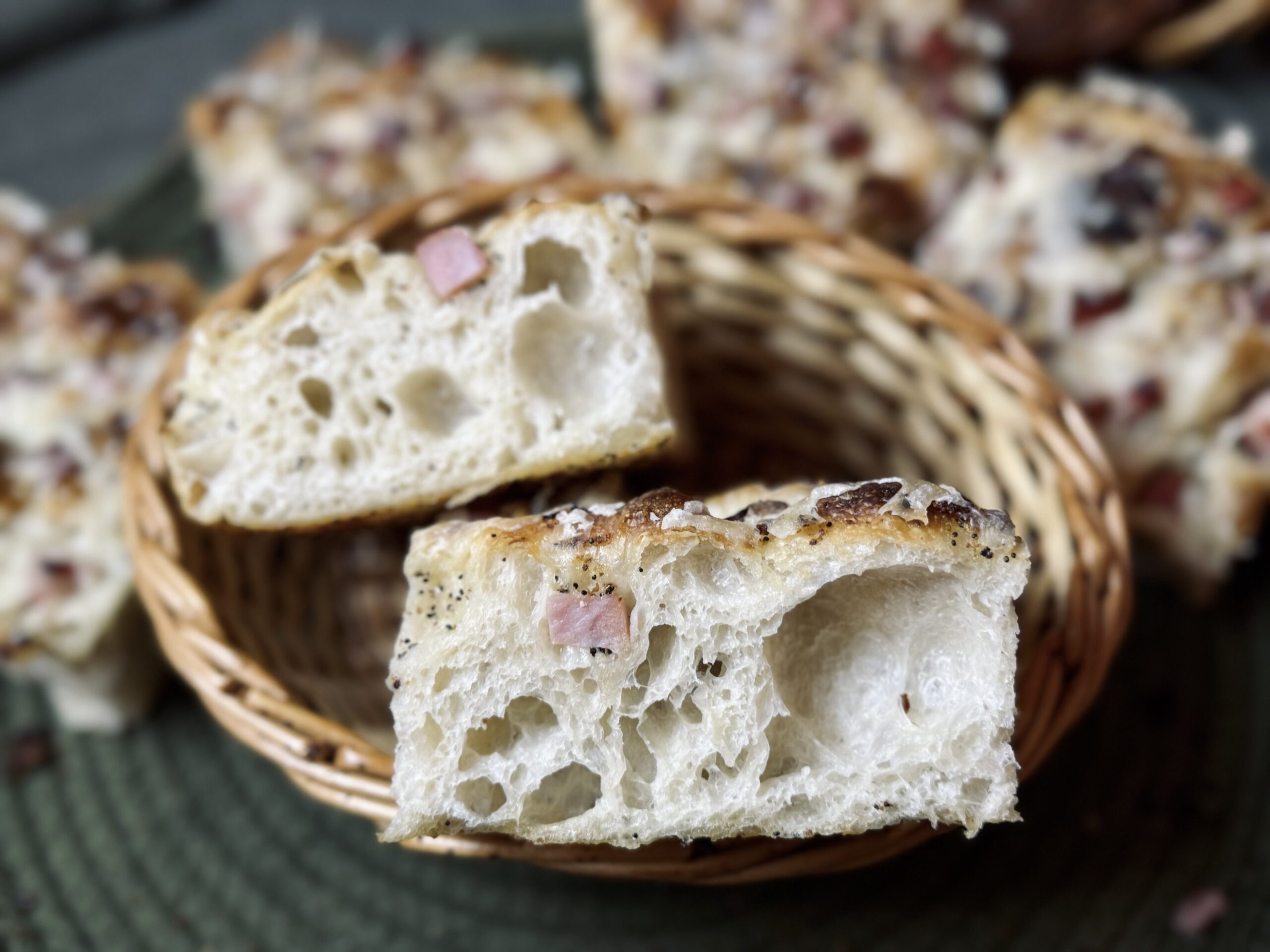
Suggested Timelines
Suggested Timeline
DAY 1
8:00 a.m.
- Mix the dough.
8:30 a.m. – 11:00 a.m.
- Strengthen the dough through folds.
1:00 – 3:00 p.m.
- Dump into baking dish.
- Transfer to refrigerator overnight.
DAY 2
8:00 a.m.
- Remove from refrigerator.
- Proof on counter.
1:00 p.m. – 4:00 p.m.
- Top and dimple.
- Bake and enjoy!
All-In-One-Day Timeline
DAY 1
8:00 a.m.
- Mix the dough.
8:30 a.m. – 11:00 a.m.
- Strengthen the dough through folds.
1:00 – 3:00 p.m.
- Dump into baking dish.
3:00 – 7:00 p.m.
- Top and dimple.
- Bake and enjoy!
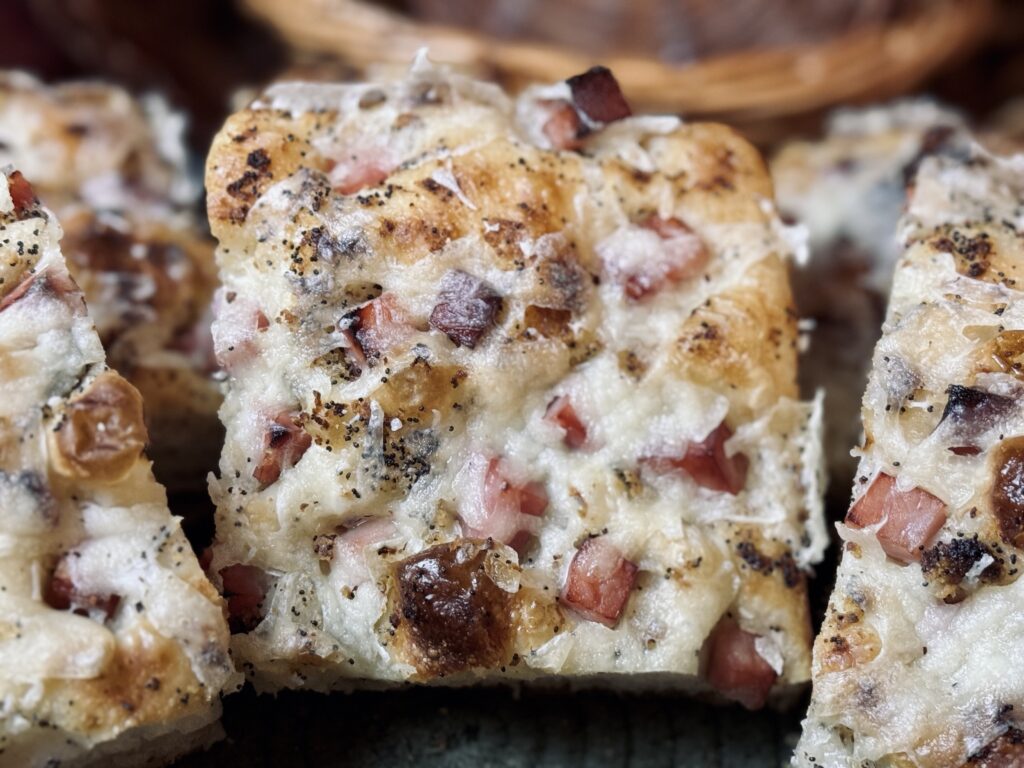
Other Variations To Try
📌 Quick Tip: Read the recipe in its entirety before you start cooking. This will help you understand the ingredients, steps, and timing involved, and allow you to prepare any necessary equipment or ingredients beforehand.
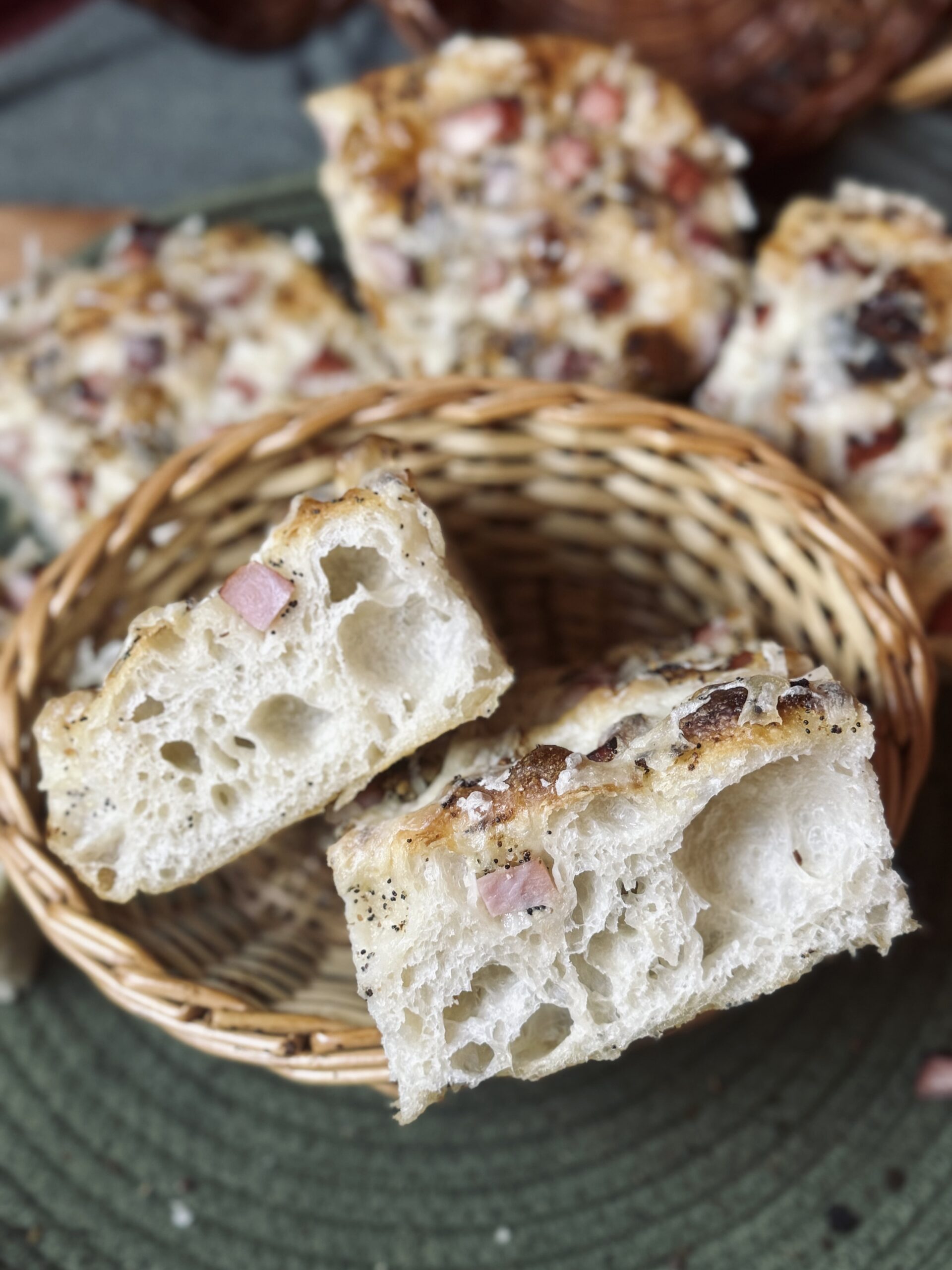
Hawaiian Focaccia
Ingredients
Dough
Butter Sauce
Topping
Instructions
Make the focaccia dough.
-
Mix together the flour, water, starter, and salt in a bowl for about five minutes. The flour should be fully incorporated and gluten development should be initiated. Cover the dough with a lid, damp towel, or plastic cling wrap and let it rest for 30 minutes.
-
Thirty minutes after mixing, begin four sets of folds, spaced thirty minutes apart. I prefer coil folds for this bread, as it is a fairly wet dough.
- To coil fold the dough: Pull the dough up from the middle, stretching up as far as it will go. Then, fold the dough under itself in each cardinal direction before covering the dough and allowing it to rest once more.
-
After folds are complete, allow the dough to rest until it has increased in volume by about 50% (about 3 more hours at 70 F [21 C]).
Make the butter sauce.
-
Whisk together all ingredients for the butter sauce in a small bowl.
Shape and proof the focaccia.
-
Generously brush the butter sauce all over the bottom (not the sides!) of a 9X13 baking dish. I love my 9X13 USA pan for this, as I've found it is the only pan to which the focaccia does not cling during baking. Dump the proofed dough into the pan, stretching to mostly fill the container.
-
Brush the remaining melted butter sauce all over the top of the focaccia.
-
At this point, you can refrigerate the dough until the next day or let it rest once more until it is finished proofing.
-
For refrigerated dough: The next morning, remove the dough from the refrigerator and let it rest until it is very puffy, bubbly, and filling up the pan. The dough should approximately double in size, 5-7 hours at 70 F (21 C).
For room temperature dough: After shaping, let the dough rest again until it is very puffy, bubbly, and filling up the pan. The dough should approximately double in size, 4-5 hours at 70 F (21 C).
Top and bake the focaccia.
-
Preheat an oven to 450 F (230 C).
-
Add all of the diced ham steak to the top of the focaccia, dimpling all over.
NOTE: At this point, if you notice large bubbles coming to the surface and popping, this is a sign that the dough is either over-proofed or that it needed more mixing time in the beginning. The crumb will be denser, but the texture may still be light. You want to feel a very airy dough with a few bubbles that come to the surface (and do not pop) during dimpling. -
Bake the focaccia for 25-30 minutes. The focaccia should be baked through and brown, and the ham should be perfectly roasted and warm.
-
Pull the focaccia out of the oven and grate Swiss cheese all over.
-
Bake about 3-5 minutes more, until the cheese is melted, bubbly, and browned to your liking.
-
Cool the focaccia for 15-20 minutes before slicing. Enjoy!
Servings 6
- Amount Per Serving
- Calories 886.9kcal
- % Daily Value *
- Total Fat 37.79g59%
- Saturated Fat 18.14g91%
- Trans Fat 0.19g
- Cholesterol 175.7mg59%
- Sodium 4667.92mg195%
- Potassium 997.96mg29%
- Total Carbohydrate 69.33g24%
- Dietary Fiber 2.89g12%
- Sugars 1.05g
- Protein 63.55g128%
- Vitamin A 186.51 IU
- Vitamin C 0.35 mg
- Calcium 241.47 mg
- Iron 6.31 mg
- Vitamin D 1.5 IU
- Vitamin E 1.42 IU
- Vitamin K 2.05 mcg
- Thiamin 1.73 mg
- Riboflavin 0.95 mg
- Niacin 13.42 mg
- Vitamin B6 0.77 mg
- Folate 47.57 mcg
- Vitamin B12 2.08 mcg
- Phosphorus 759.52 mg
- Magnesium 82.23 mg
- Zinc 6.57 mg
* Nutrition values are auto-calculated and should be used as an approximation only. In addition, the values may not accurately represent the serving divisions of the recipe, instead representing the nutrition of the recipe as a whole.
Notes
- Storage: Store in the fridge three to five days. Toast or microwave to warm.
